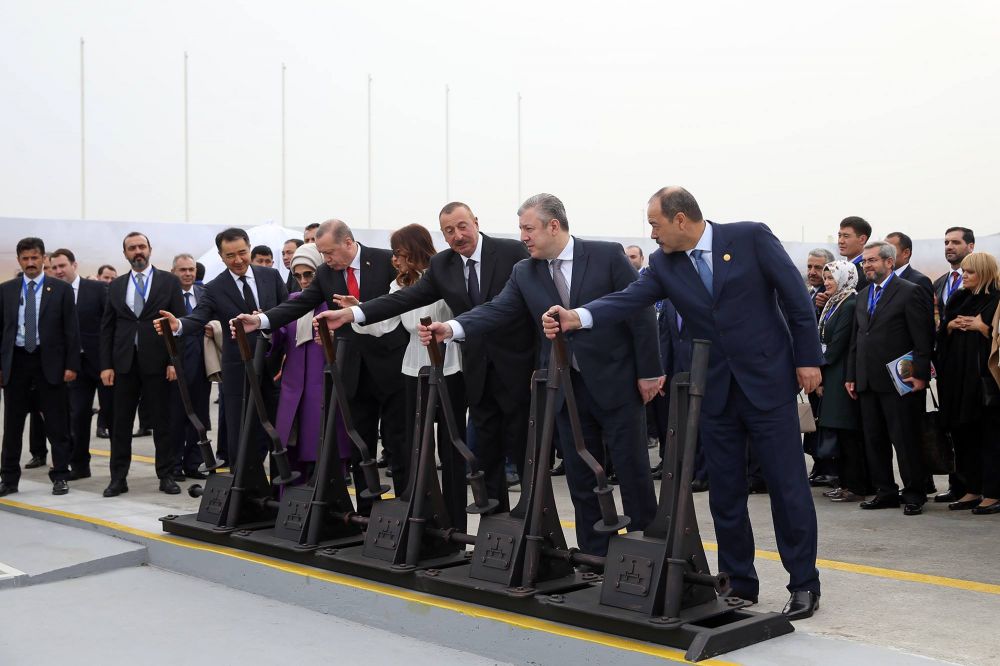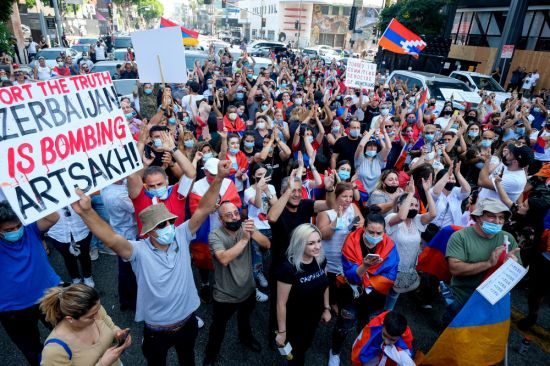The South Caucasus, straddling Asia and Europe, is a complex area of ethnic, nationalist and great-power rivalries. The post-Soviet Union era has been marked by flareups of military conflict and economic, social and political confrontation. Taking a regional perspective, AsiaGlobal Fellow 2020/21 Mher D Sahakyan analyzes the major issues at play and offers ways to resolve the tensions and differences among the countries involved.
Who is pulling the levers?: Heads of government of, from left to right, Kazakhstan, Turkey, Azerbaijan, Georgia and Uzbekistan at the 2017 inauguration of the Baku-Tbilisi-Kars railway project (Credit: Government of Georgia)
The South Caucasus – roughly 200,000 square kilometers of rugged terrain encompassing Georgia, Armenia and Azerbaijan – is a strategically important crossroads with its vast sources of oil, gas, metals and fresh water. Through this region, Russia seeks to gain a presence in the Middle East and Persian Gulf, while Turkey aims to connect with the Central Asian Turkic-speaking states, Iran links to the Black Sea, Europe ventures towards Asia, and China cozies up to western Asia and Europe.
During the last years of the Soviet Union, longstanding territorial disputes among different nationalities expanded to large scale military clashes. As a result, the conflict in Nagorno-Karabakh – an Armenian-majority area trying to secede from both the USSR and the Azerbaijan Soviet Socialist Republic – erupted. This military conflict ended by the de facto creation of new states in the South Caucasus. Negotiations for the final de jure status of Artsakh (as Nagorno-Karabakh is referred to in Armenian) between Armenia and Azerbaijan are still ongoing under the auspices of the Minsk Group, created in 1992 by the Organization for Security and Co-operation in Europe (OSCE), with Russia, the US and France as co-chairs.
Meanwhile, the internal situation in Georgia has also been unstable for years, with several ethnic clashes. All these developments have prevented economic interconnection of the region and created a dysfunctional political situation, which has provided opportunities for external players to interfere.
The Russian factor
Russia still sees the South Caucasus as being in its sphere of influence. In the Artsakh conflict, Moscow tries to play a neutral role to maintain good relations with both Armenia and Azerbaijan, giving it some influence and leverage. Armenia is a military ally of Russia, and Moscow has a military base in Gyumri, Armenia’s second biggest city, and an airfield in Yerevan, the capital. Armenia is a member of the Russia-led Eurasian Economic Union (EAEU) and the Collective Security Treaty Organization (CSTO). Armenia needs Russia to keep secure its western border with Azerbaijan’s main ally, Turkey, while Russia needs Armenia as buffer to impede the aspirations of some Turkish politicians to create a pan-Turkic state encompassing Turkey, Azerbaijan, Central Asia and Xinjiang.
With Azerbaijan, Russia has a strategic partnership. Moscow is the main supplier of arms to Azerbaijan, which is causing problems in Russo-Armenian relations. Russia’s military involvement extends further into the Caucasus. It fought a brief war with Georgia in 2008, when Moscow supported the secessionist areas of Abkhazia and South Ossetia.
In sum, Russia still plays especially important role in South Caucasus, as it is actively involved in regional conflicts. Moscow will try to keep its influence in Armenia and Azerbaijan with its involvement in the Karabakh conflict and will find ways to prompt political changes in Georgia to reorient the former Soviet republic back toward favoring Moscow.
The American factor
After the collapse of the Soviet Union in 1991, the US developed relations with the newly emerged South Caucasus states and strengthened its position in the region. The US forged a strategic partnership with Georgia and encouraged then president Mikheil Saakashvili to remove Russian military bases. Moscow still has minimal influence in Georgian internal politics. Tbilisi’s national security concept includes eventual membership in the North Atlantic Treaty Organization (NATO), the western security alliance. This clashes with the interests of Russia, which has tried to block NATO’s expansion. Moscow sees it as a challenge to its national security.
Georgia paid a remarkably high price for its orientation towards the US, losing control over Abkhazia and South Ossetia, when Moscow recognized them as independent states. But after its war with Russia, Georgia received US$1 billion in aid from the US, which was critical for maintaining political and social stability in the country. Washington also extended special trade preferences to Tbilisi.
The US will continue to finance and support political parties in the region if that helps to weaken Russian influence and move countries into the Western camp. South Caucasus states will continue to finesse their ties with the US to maintain a balance of power in the region.
The European factor
In 1993, as the post-Soviet world was taking shape, the European Union launched the Transport Corridor Europe-Caucasus-Asia (TRACECA) project, which aimed to connect Europe with the South Caucasus and Asia without passing through Russian territory. Sixteen years later, the EU set up the Eastern Partnership to deepen relations with Armenia, Georgia, Azerbaijan and other states.
Georgia’s major foreign-policy priority is to become a member of the European Union and has indicated that it will apply by 2024. In June 2014, Georgia signed an Association Agreement with the EU, which included the creation of a Deep and Comprehensive Free Trade Area between the two. Armenia too has aimed to strengthen cooperation with the EU, signing a Comprehensive and Enhanced Partnership Agreement in 2017. The EU, meanwhile, is interested in cooperation with Azerbaijan on natural resources as it sees Azerbaijani oil and gas as an alternative to Russian energy.
The EU has long supported South Caucasus nations in their efforts to implement economic, social-justice and public-administration reforms. In Armenia and Georgia, organizations and institutions for the protection of human rights and freedom of speech have been launched, aligning the two countries with EU values and catalyzing their democratic transformations. Azerbaijan is an autocratic state, with the Aliyev family in control. Ilham Aliyev has been president (his wife is vice president) since 2003, when he succeeded his father who ruled from 1993.
The Chinese factor
In recent years, China has been trying to develop relations with Armenia, Georgia and Azerbaijan in the framework of its global infrastructure showcase, the Belt and Road Initiative (BRI). While China has invested little in Armenia, it has poured several hundred million dollars into Georgia and Azerbaijan, which are both members of the Beijing-led Asian Infrastructure Investment Bank (AIIB). (Armenia is a prospective member.) Among the major AIIB deals signed: Azerbaijan received a US$600-million loan to build a trans-Anatolian gas pipeline, while Georgia received US$114 million to build a bypass road.
The South Caucasus is a key crossroads in the China-Central Asia-Western Asia Economic Corridor (CCAWEC). Major projects include the 500-mile Baku-Tbilisi-Kars railway, which opened in 2017 and connects seaports in the Caspian Sea with the Mediterranean. Armenia is spending US$1.5 billion on building the 350-mile North-South Road Corridor, which aims to links ports in the Persian Gulf with those in Georgia on the Black Sea.
Taking into consideration China’s growing economic influence in the South Caucasus and its neighbors, the countries in the region are strongly interested in the BRI. This would seem to underscore how time is working for China and, in the near future, Beijing’s growing economic presence will also give it greater political influence.
The Turkish factor
Since regaining its independence, Georgia has built good relations with Turkey. The two countries signed a free-trade agreement, and Turkey is the main trade partner of Georgia.
After the collapse of the Soviet Union, Turkey and Azerbaijan came together to cooperate in the political, military, economic and energy spheres. Leaders in both states like to talk of “one nation, two states”, recognizing that they share a language and culture. Turkey’s influence in Azerbaijan is enormous, as Ankara provides Baku with strong support in its conflict with Armenia, unilaterally closing the Turkish-Armenian border. Turkey’s involvement in the 44-day war over Artsakh, which erupted in September 27, 2020, was decisive, as the help of Turkish military intelligence and drones helped Azerbaijan overcome the army of Artsakh, which was backed by Armenia and equipped mostly with the weapons produced in Soviet Union in 1980s.
Turkey sent jihadists from Syria to Azerbaijan to take part in military operations against Christian Armenians of Artsakh, action confirmed by French President Emanuel Macron on October 1, 2020, during the EU Council meeting and by the Russian Ministry of Foreign Affairs as well. As a result of fighting, Azerbaijan occupied Artsakh’s second main city and many other settlements. Baku also took under control of seven regions, which it lost during the First Artsakh war in the 1990s. The Armenian side lost more than 4,000 soldiers and had to agree to an unfair Russian-brokered ceasefire, which allowed Russian peacekeepers to enter Artsakh. As a result, after 100 years, Turkish troops returned to Azerbaijan, where they will control energy and transportation infrastructure that connects Europe with Asia.
Ankara’s strong alliance with Baku during the war could help Turkey weaken its historical adversary, Armenia, which has become isolated and has tumbled into political turmoil. It has also shaken the strategic position of Russia in the region. For this reason, in Armenia, there are growing calls for a Russia-Armenia military alignment. In sum, Turkey has gained strong political, economic and military leverage in the South Caucasus, where it will remain embedded for a long time because of its special relations and rising influence in Azerbaijan.
For its part, Azerbaijan must face the reality that the people of Artsakh have chosen the right of self-determination and will resist any attempt to end the dispute through military action, given that none of the previous clashes since the 1990s have resulted in a solution.
The EU and the US must continue their constructive roles in support of the democratic transformation of the states of the South Caucasus. The countries in the region should explore what incremental steps they could take to build trust among them. One easy step would be for them to establish a joint task force for sharing their experiences in the fight against Covid-19, a common enemy that does not respect borders. This would be a highly appropriate and effective confidence-building measure that the region sorely needs.
Further reading:
Mher Sahakyan
2022 AsiaGlobal Fellow, Asia Global Institute, The University of Hong Kong, and the China-Eurasia Council for Political and Strategic Research
Check out here for more research and analysis from Asian perspectives.



